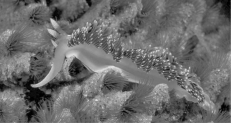Multiple Choice
This nudibranch, a type of sea slug, has many reddish cerata on its dorsal surface, as well as two, white-tipped rhinophores located on the head.

The nontaxonomic term sea slug encompasses a wide variety of marine gastropods. One feature they share as adults is the lack of a shell. We might think, therefore, that they represent defenseless morsels for predators. In fact, sea slugs have multiple defenses. Some sea slugs prey on sponges and concentrate sponge toxins in their tissues. Others feed on cnidarians, digesting everything except the nematocysts, which they then transfer to their own skins. Whereas the most brightly colored sea slugs are often highly toxic, others are nontoxic and mimic the coloration of the toxic species. Their colors are mostly derived from pigments in their prey. There are also sea slugs that use their coloration to blend into their environments.
-Which structure do sea slugs use to feed on their prey?
A) nematocysts
B) a sharp beak
C) an incurrent siphon
D) a radula
E) a mantle cavity
Correct Answer:

Verified
Correct Answer:
Verified
Q24: The crown-of-thorns sea star, Acanthaster planci, preys
Q25: The excretory organs of annelids are<br>A) protonephridia.<br>B)
Q26: Had the teacher wanted to point out
Q27: An elementary school science teacher decided to
Q28: The reason their exoskeletons cannot protect the
Q30: One should expect to find the "9
Q31: This nudibranch, a type of sea slug,
Q32: An elementary school science teacher decided to
Q33: A brachiopod can be distinguished from a
Q34: Which of the following is a characteristic